A Comparative Study of Education and Learning in India and UK
VerifiedAdded on 2020/02/12
|11
|3455
|1252
Literature Review
AI Summary
This literature review offers a comparative analysis of the education systems in India and the United Kingdom. It begins with an introduction highlighting the importance of education and the rationale for comparing these two countries, focusing on differences in teaching styles and technology usage. The review then explores the education policies and systems of both nations, including historical developments, government initiatives, and the role of private and public sectors. It delves into the structure of primary schools, teacher qualifications, classroom resources, and teaching approaches in both India and the UK, comparing their respective strengths and weaknesses. The review also examines how the education system in India and the UK impacts the children and the overall learning environment. The review concludes by summarizing the key findings and providing references for further research. The review highlights the differences in the education systems in both countries, including their strengths and weaknesses and offers insights into the policies, school structures, teacher qualifications, and classroom resources. The assignment is a valuable resource for students studying comparative education and highlights the importance of understanding different educational approaches to improve the learning experience.
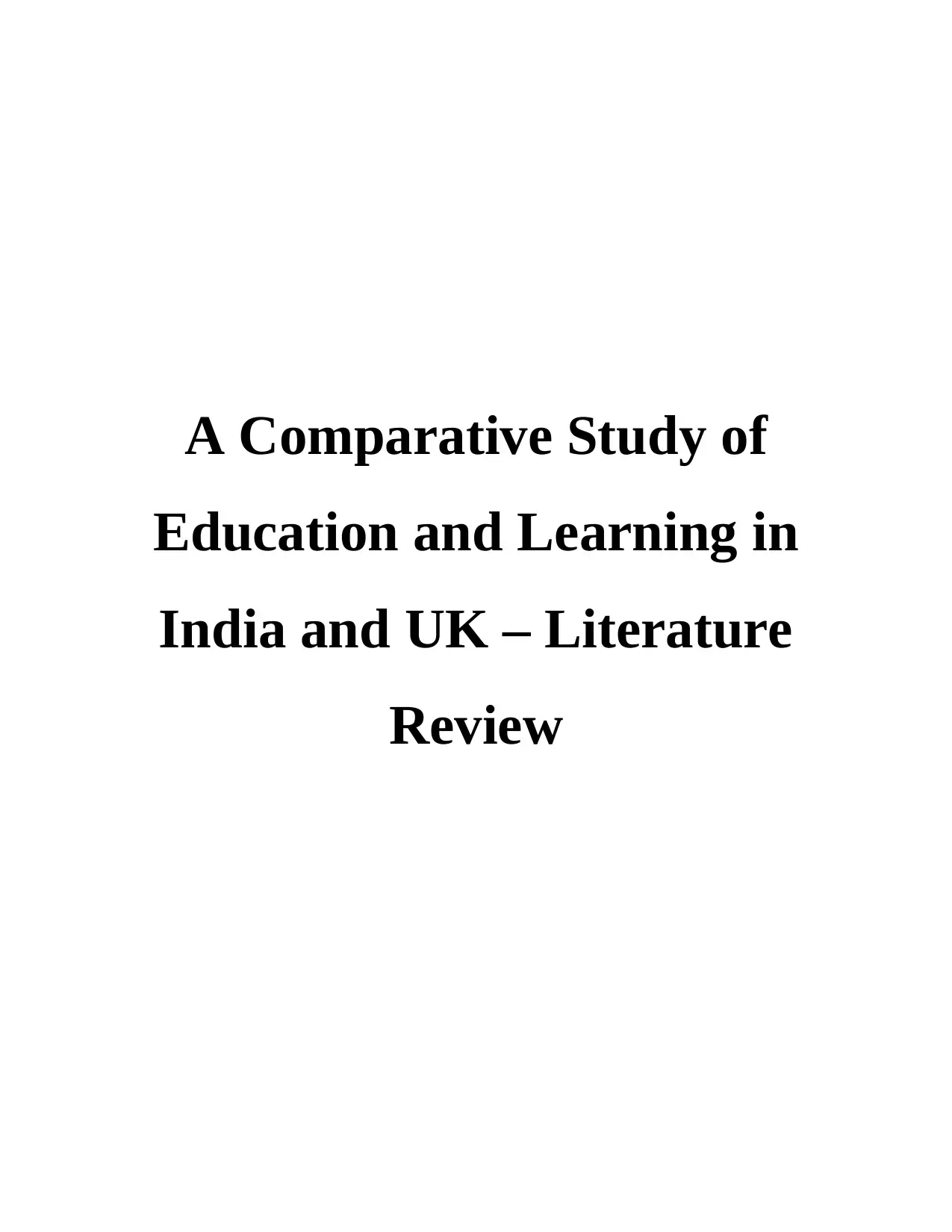
A Comparative Study of
Education and Learning in
India and UK – Literature
Review
Education and Learning in
India and UK – Literature
Review
Paraphrase This Document
Need a fresh take? Get an instant paraphrase of this document with our AI Paraphraser
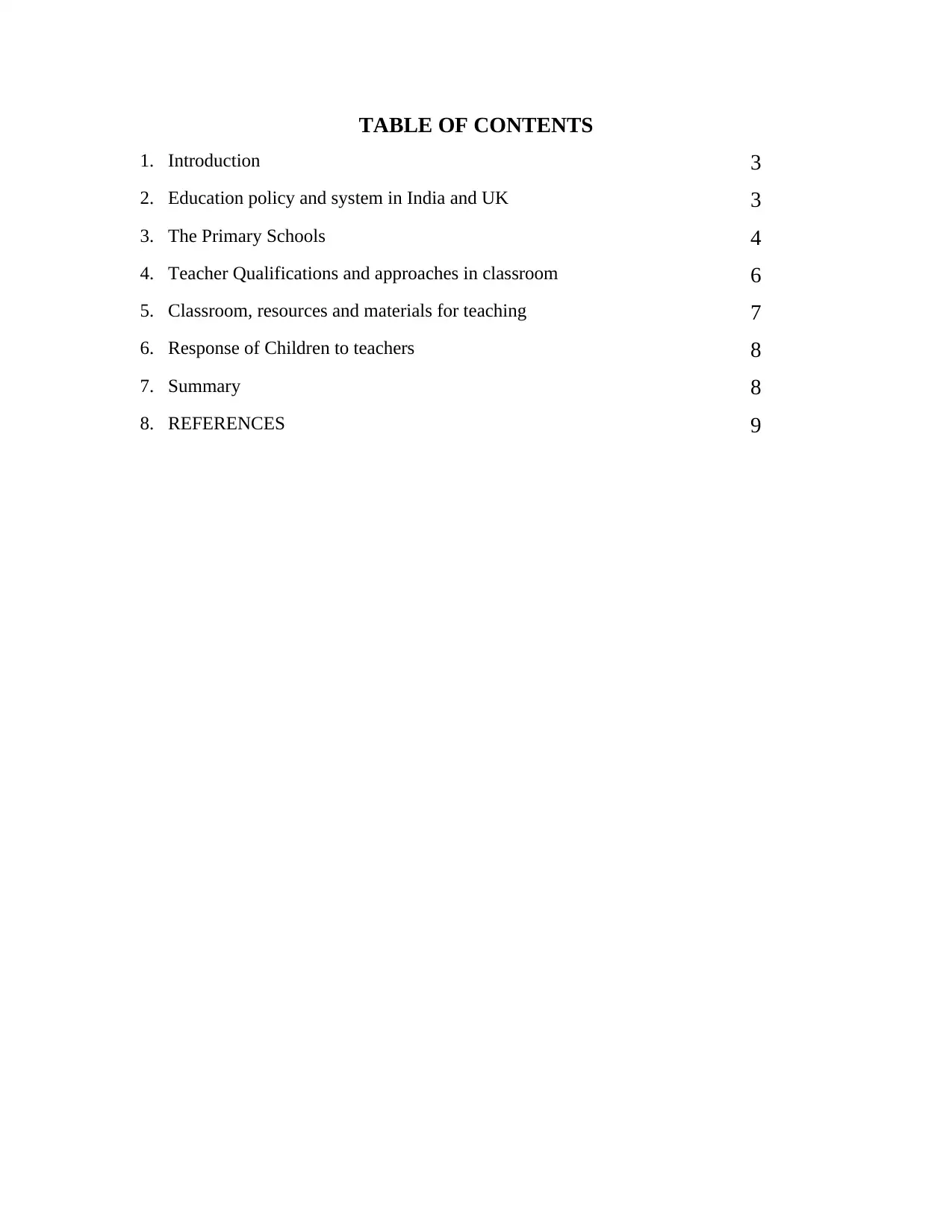
TABLE OF CONTENTS
1. Introduction 3
2. Education policy and system in India and UK 3
3. The Primary Schools 4
4. Teacher Qualifications and approaches in classroom 6
5. Classroom, resources and materials for teaching 7
6. Response of Children to teachers 8
7. Summary 8
8. REFERENCES 9
1. Introduction 3
2. Education policy and system in India and UK 3
3. The Primary Schools 4
4. Teacher Qualifications and approaches in classroom 6
5. Classroom, resources and materials for teaching 7
6. Response of Children to teachers 8
7. Summary 8
8. REFERENCES 9
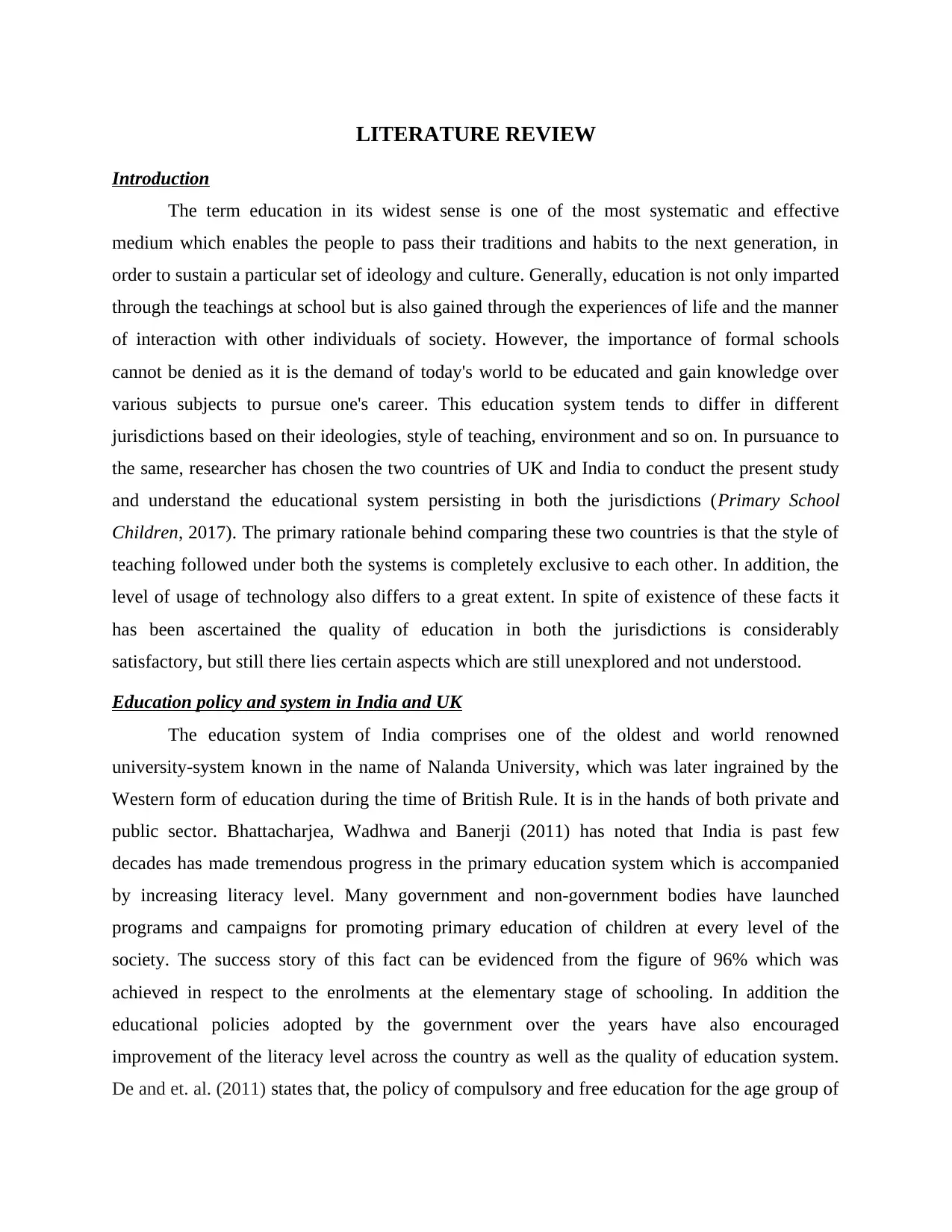
LITERATURE REVIEW
Introduction
The term education in its widest sense is one of the most systematic and effective
medium which enables the people to pass their traditions and habits to the next generation, in
order to sustain a particular set of ideology and culture. Generally, education is not only imparted
through the teachings at school but is also gained through the experiences of life and the manner
of interaction with other individuals of society. However, the importance of formal schools
cannot be denied as it is the demand of today's world to be educated and gain knowledge over
various subjects to pursue one's career. This education system tends to differ in different
jurisdictions based on their ideologies, style of teaching, environment and so on. In pursuance to
the same, researcher has chosen the two countries of UK and India to conduct the present study
and understand the educational system persisting in both the jurisdictions (Primary School
Children, 2017). The primary rationale behind comparing these two countries is that the style of
teaching followed under both the systems is completely exclusive to each other. In addition, the
level of usage of technology also differs to a great extent. In spite of existence of these facts it
has been ascertained the quality of education in both the jurisdictions is considerably
satisfactory, but still there lies certain aspects which are still unexplored and not understood.
Education policy and system in India and UK
The education system of India comprises one of the oldest and world renowned
university-system known in the name of Nalanda University, which was later ingrained by the
Western form of education during the time of British Rule. It is in the hands of both private and
public sector. Bhattacharjea, Wadhwa and Banerji (2011) has noted that India is past few
decades has made tremendous progress in the primary education system which is accompanied
by increasing literacy level. Many government and non-government bodies have launched
programs and campaigns for promoting primary education of children at every level of the
society. The success story of this fact can be evidenced from the figure of 96% which was
achieved in respect to the enrolments at the elementary stage of schooling. In addition the
educational policies adopted by the government over the years have also encouraged
improvement of the literacy level across the country as well as the quality of education system.
De and et. al. (2011) states that, the policy of compulsory and free education for the age group of
Introduction
The term education in its widest sense is one of the most systematic and effective
medium which enables the people to pass their traditions and habits to the next generation, in
order to sustain a particular set of ideology and culture. Generally, education is not only imparted
through the teachings at school but is also gained through the experiences of life and the manner
of interaction with other individuals of society. However, the importance of formal schools
cannot be denied as it is the demand of today's world to be educated and gain knowledge over
various subjects to pursue one's career. This education system tends to differ in different
jurisdictions based on their ideologies, style of teaching, environment and so on. In pursuance to
the same, researcher has chosen the two countries of UK and India to conduct the present study
and understand the educational system persisting in both the jurisdictions (Primary School
Children, 2017). The primary rationale behind comparing these two countries is that the style of
teaching followed under both the systems is completely exclusive to each other. In addition, the
level of usage of technology also differs to a great extent. In spite of existence of these facts it
has been ascertained the quality of education in both the jurisdictions is considerably
satisfactory, but still there lies certain aspects which are still unexplored and not understood.
Education policy and system in India and UK
The education system of India comprises one of the oldest and world renowned
university-system known in the name of Nalanda University, which was later ingrained by the
Western form of education during the time of British Rule. It is in the hands of both private and
public sector. Bhattacharjea, Wadhwa and Banerji (2011) has noted that India is past few
decades has made tremendous progress in the primary education system which is accompanied
by increasing literacy level. Many government and non-government bodies have launched
programs and campaigns for promoting primary education of children at every level of the
society. The success story of this fact can be evidenced from the figure of 96% which was
achieved in respect to the enrolments at the elementary stage of schooling. In addition the
educational policies adopted by the government over the years have also encouraged
improvement of the literacy level across the country as well as the quality of education system.
De and et. al. (2011) states that, the policy of compulsory and free education for the age group of
⊘ This is a preview!⊘
Do you want full access?
Subscribe today to unlock all pages.

Trusted by 1+ million students worldwide
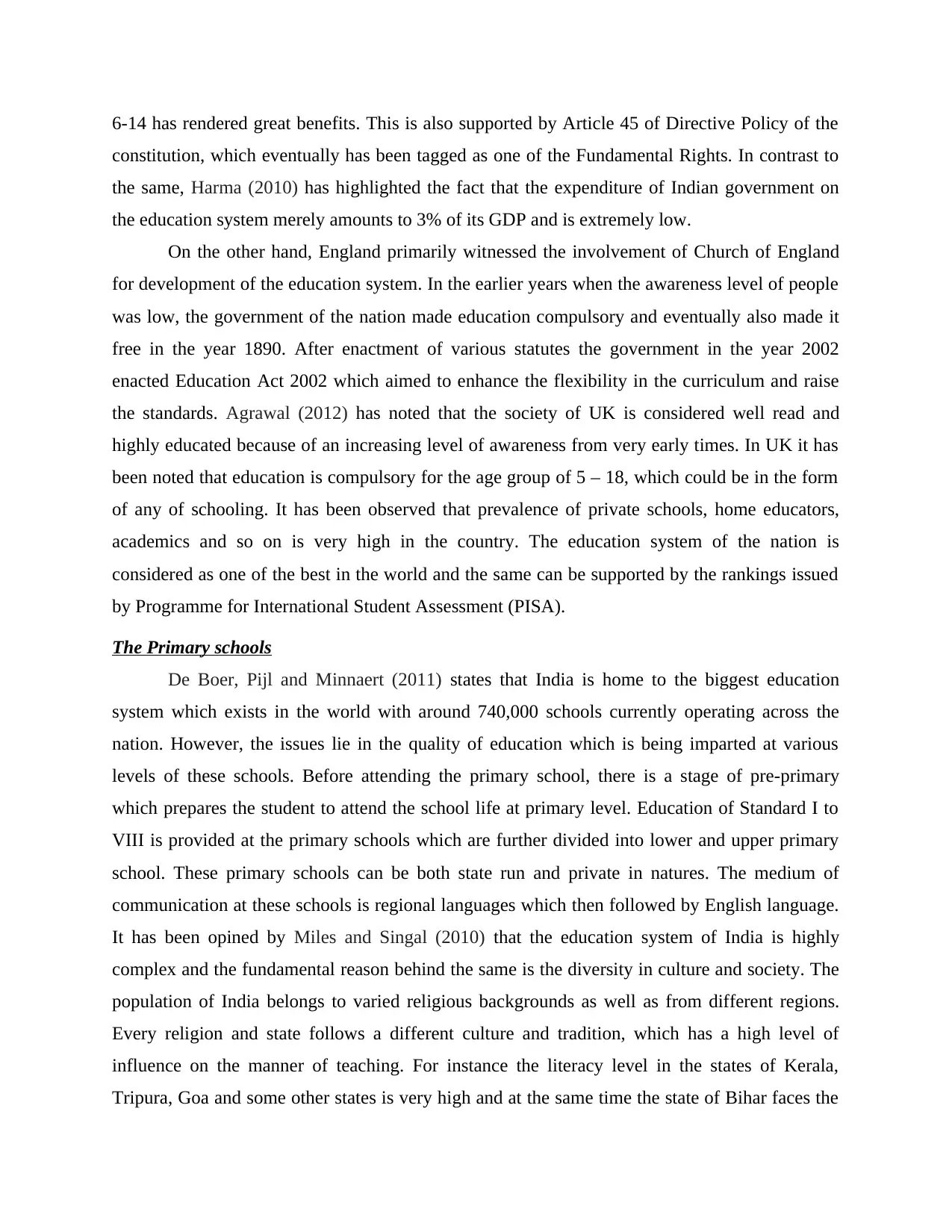
6-14 has rendered great benefits. This is also supported by Article 45 of Directive Policy of the
constitution, which eventually has been tagged as one of the Fundamental Rights. In contrast to
the same, Harma (2010) has highlighted the fact that the expenditure of Indian government on
the education system merely amounts to 3% of its GDP and is extremely low.
On the other hand, England primarily witnessed the involvement of Church of England
for development of the education system. In the earlier years when the awareness level of people
was low, the government of the nation made education compulsory and eventually also made it
free in the year 1890. After enactment of various statutes the government in the year 2002
enacted Education Act 2002 which aimed to enhance the flexibility in the curriculum and raise
the standards. Agrawal (2012) has noted that the society of UK is considered well read and
highly educated because of an increasing level of awareness from very early times. In UK it has
been noted that education is compulsory for the age group of 5 – 18, which could be in the form
of any of schooling. It has been observed that prevalence of private schools, home educators,
academics and so on is very high in the country. The education system of the nation is
considered as one of the best in the world and the same can be supported by the rankings issued
by Programme for International Student Assessment (PISA).
The Primary schools
De Boer, Pijl and Minnaert (2011) states that India is home to the biggest education
system which exists in the world with around 740,000 schools currently operating across the
nation. However, the issues lie in the quality of education which is being imparted at various
levels of these schools. Before attending the primary school, there is a stage of pre-primary
which prepares the student to attend the school life at primary level. Education of Standard I to
VIII is provided at the primary schools which are further divided into lower and upper primary
school. These primary schools can be both state run and private in natures. The medium of
communication at these schools is regional languages which then followed by English language.
It has been opined by Miles and Singal (2010) that the education system of India is highly
complex and the fundamental reason behind the same is the diversity in culture and society. The
population of India belongs to varied religious backgrounds as well as from different regions.
Every religion and state follows a different culture and tradition, which has a high level of
influence on the manner of teaching. For instance the literacy level in the states of Kerala,
Tripura, Goa and some other states is very high and at the same time the state of Bihar faces the
constitution, which eventually has been tagged as one of the Fundamental Rights. In contrast to
the same, Harma (2010) has highlighted the fact that the expenditure of Indian government on
the education system merely amounts to 3% of its GDP and is extremely low.
On the other hand, England primarily witnessed the involvement of Church of England
for development of the education system. In the earlier years when the awareness level of people
was low, the government of the nation made education compulsory and eventually also made it
free in the year 1890. After enactment of various statutes the government in the year 2002
enacted Education Act 2002 which aimed to enhance the flexibility in the curriculum and raise
the standards. Agrawal (2012) has noted that the society of UK is considered well read and
highly educated because of an increasing level of awareness from very early times. In UK it has
been noted that education is compulsory for the age group of 5 – 18, which could be in the form
of any of schooling. It has been observed that prevalence of private schools, home educators,
academics and so on is very high in the country. The education system of the nation is
considered as one of the best in the world and the same can be supported by the rankings issued
by Programme for International Student Assessment (PISA).
The Primary schools
De Boer, Pijl and Minnaert (2011) states that India is home to the biggest education
system which exists in the world with around 740,000 schools currently operating across the
nation. However, the issues lie in the quality of education which is being imparted at various
levels of these schools. Before attending the primary school, there is a stage of pre-primary
which prepares the student to attend the school life at primary level. Education of Standard I to
VIII is provided at the primary schools which are further divided into lower and upper primary
school. These primary schools can be both state run and private in natures. The medium of
communication at these schools is regional languages which then followed by English language.
It has been opined by Miles and Singal (2010) that the education system of India is highly
complex and the fundamental reason behind the same is the diversity in culture and society. The
population of India belongs to varied religious backgrounds as well as from different regions.
Every religion and state follows a different culture and tradition, which has a high level of
influence on the manner of teaching. For instance the literacy level in the states of Kerala,
Tripura, Goa and some other states is very high and at the same time the state of Bihar faces the
Paraphrase This Document
Need a fresh take? Get an instant paraphrase of this document with our AI Paraphraser
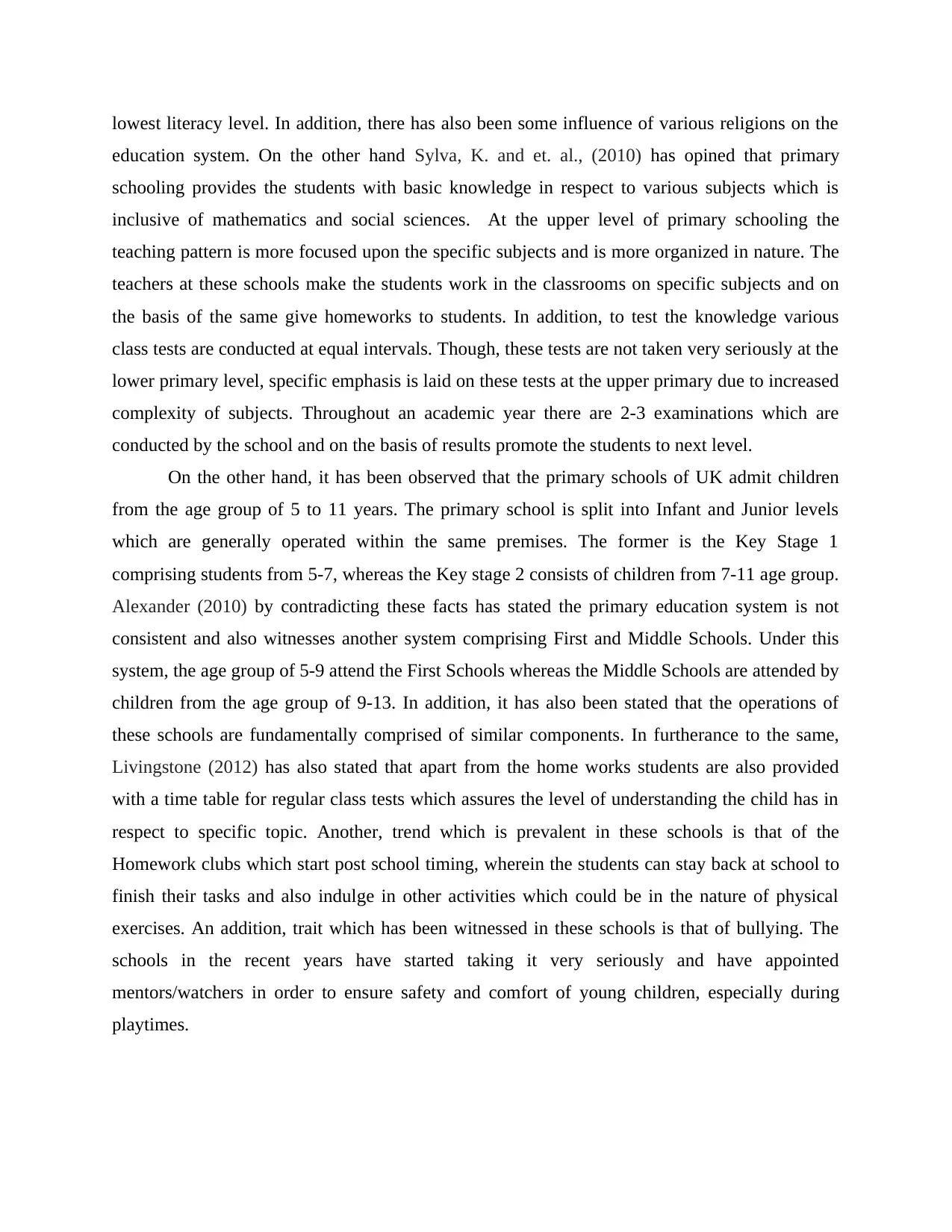
lowest literacy level. In addition, there has also been some influence of various religions on the
education system. On the other hand Sylva, K. and et. al., (2010) has opined that primary
schooling provides the students with basic knowledge in respect to various subjects which is
inclusive of mathematics and social sciences. At the upper level of primary schooling the
teaching pattern is more focused upon the specific subjects and is more organized in nature. The
teachers at these schools make the students work in the classrooms on specific subjects and on
the basis of the same give homeworks to students. In addition, to test the knowledge various
class tests are conducted at equal intervals. Though, these tests are not taken very seriously at the
lower primary level, specific emphasis is laid on these tests at the upper primary due to increased
complexity of subjects. Throughout an academic year there are 2-3 examinations which are
conducted by the school and on the basis of results promote the students to next level.
On the other hand, it has been observed that the primary schools of UK admit children
from the age group of 5 to 11 years. The primary school is split into Infant and Junior levels
which are generally operated within the same premises. The former is the Key Stage 1
comprising students from 5-7, whereas the Key stage 2 consists of children from 7-11 age group.
Alexander (2010) by contradicting these facts has stated the primary education system is not
consistent and also witnesses another system comprising First and Middle Schools. Under this
system, the age group of 5-9 attend the First Schools whereas the Middle Schools are attended by
children from the age group of 9-13. In addition, it has also been stated that the operations of
these schools are fundamentally comprised of similar components. In furtherance to the same,
Livingstone (2012) has also stated that apart from the home works students are also provided
with a time table for regular class tests which assures the level of understanding the child has in
respect to specific topic. Another, trend which is prevalent in these schools is that of the
Homework clubs which start post school timing, wherein the students can stay back at school to
finish their tasks and also indulge in other activities which could be in the nature of physical
exercises. An addition, trait which has been witnessed in these schools is that of bullying. The
schools in the recent years have started taking it very seriously and have appointed
mentors/watchers in order to ensure safety and comfort of young children, especially during
playtimes.
education system. On the other hand Sylva, K. and et. al., (2010) has opined that primary
schooling provides the students with basic knowledge in respect to various subjects which is
inclusive of mathematics and social sciences. At the upper level of primary schooling the
teaching pattern is more focused upon the specific subjects and is more organized in nature. The
teachers at these schools make the students work in the classrooms on specific subjects and on
the basis of the same give homeworks to students. In addition, to test the knowledge various
class tests are conducted at equal intervals. Though, these tests are not taken very seriously at the
lower primary level, specific emphasis is laid on these tests at the upper primary due to increased
complexity of subjects. Throughout an academic year there are 2-3 examinations which are
conducted by the school and on the basis of results promote the students to next level.
On the other hand, it has been observed that the primary schools of UK admit children
from the age group of 5 to 11 years. The primary school is split into Infant and Junior levels
which are generally operated within the same premises. The former is the Key Stage 1
comprising students from 5-7, whereas the Key stage 2 consists of children from 7-11 age group.
Alexander (2010) by contradicting these facts has stated the primary education system is not
consistent and also witnesses another system comprising First and Middle Schools. Under this
system, the age group of 5-9 attend the First Schools whereas the Middle Schools are attended by
children from the age group of 9-13. In addition, it has also been stated that the operations of
these schools are fundamentally comprised of similar components. In furtherance to the same,
Livingstone (2012) has also stated that apart from the home works students are also provided
with a time table for regular class tests which assures the level of understanding the child has in
respect to specific topic. Another, trend which is prevalent in these schools is that of the
Homework clubs which start post school timing, wherein the students can stay back at school to
finish their tasks and also indulge in other activities which could be in the nature of physical
exercises. An addition, trait which has been witnessed in these schools is that of bullying. The
schools in the recent years have started taking it very seriously and have appointed
mentors/watchers in order to ensure safety and comfort of young children, especially during
playtimes.
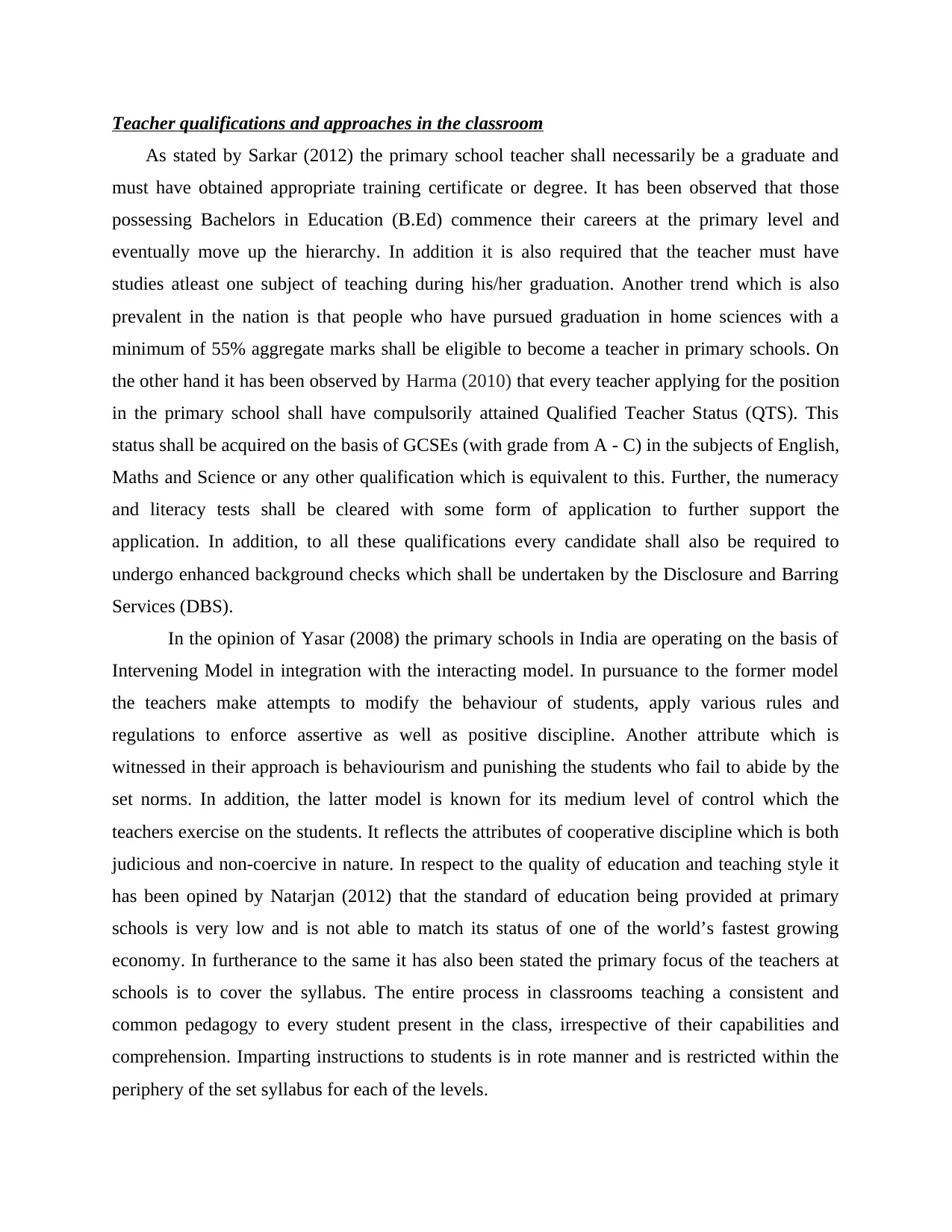
Teacher qualifications and approaches in the classroom
As stated by Sarkar (2012) the primary school teacher shall necessarily be a graduate and
must have obtained appropriate training certificate or degree. It has been observed that those
possessing Bachelors in Education (B.Ed) commence their careers at the primary level and
eventually move up the hierarchy. In addition it is also required that the teacher must have
studies atleast one subject of teaching during his/her graduation. Another trend which is also
prevalent in the nation is that people who have pursued graduation in home sciences with a
minimum of 55% aggregate marks shall be eligible to become a teacher in primary schools. On
the other hand it has been observed by Harma (2010) that every teacher applying for the position
in the primary school shall have compulsorily attained Qualified Teacher Status (QTS). This
status shall be acquired on the basis of GCSEs (with grade from A - C) in the subjects of English,
Maths and Science or any other qualification which is equivalent to this. Further, the numeracy
and literacy tests shall be cleared with some form of application to further support the
application. In addition, to all these qualifications every candidate shall also be required to
undergo enhanced background checks which shall be undertaken by the Disclosure and Barring
Services (DBS).
In the opinion of Yasar (2008) the primary schools in India are operating on the basis of
Intervening Model in integration with the interacting model. In pursuance to the former model
the teachers make attempts to modify the behaviour of students, apply various rules and
regulations to enforce assertive as well as positive discipline. Another attribute which is
witnessed in their approach is behaviourism and punishing the students who fail to abide by the
set norms. In addition, the latter model is known for its medium level of control which the
teachers exercise on the students. It reflects the attributes of cooperative discipline which is both
judicious and non-coercive in nature. In respect to the quality of education and teaching style it
has been opined by Natarjan (2012) that the standard of education being provided at primary
schools is very low and is not able to match its status of one of the world’s fastest growing
economy. In furtherance to the same it has also been stated the primary focus of the teachers at
schools is to cover the syllabus. The entire process in classrooms teaching a consistent and
common pedagogy to every student present in the class, irrespective of their capabilities and
comprehension. Imparting instructions to students is in rote manner and is restricted within the
periphery of the set syllabus for each of the levels.
As stated by Sarkar (2012) the primary school teacher shall necessarily be a graduate and
must have obtained appropriate training certificate or degree. It has been observed that those
possessing Bachelors in Education (B.Ed) commence their careers at the primary level and
eventually move up the hierarchy. In addition it is also required that the teacher must have
studies atleast one subject of teaching during his/her graduation. Another trend which is also
prevalent in the nation is that people who have pursued graduation in home sciences with a
minimum of 55% aggregate marks shall be eligible to become a teacher in primary schools. On
the other hand it has been observed by Harma (2010) that every teacher applying for the position
in the primary school shall have compulsorily attained Qualified Teacher Status (QTS). This
status shall be acquired on the basis of GCSEs (with grade from A - C) in the subjects of English,
Maths and Science or any other qualification which is equivalent to this. Further, the numeracy
and literacy tests shall be cleared with some form of application to further support the
application. In addition, to all these qualifications every candidate shall also be required to
undergo enhanced background checks which shall be undertaken by the Disclosure and Barring
Services (DBS).
In the opinion of Yasar (2008) the primary schools in India are operating on the basis of
Intervening Model in integration with the interacting model. In pursuance to the former model
the teachers make attempts to modify the behaviour of students, apply various rules and
regulations to enforce assertive as well as positive discipline. Another attribute which is
witnessed in their approach is behaviourism and punishing the students who fail to abide by the
set norms. In addition, the latter model is known for its medium level of control which the
teachers exercise on the students. It reflects the attributes of cooperative discipline which is both
judicious and non-coercive in nature. In respect to the quality of education and teaching style it
has been opined by Natarjan (2012) that the standard of education being provided at primary
schools is very low and is not able to match its status of one of the world’s fastest growing
economy. In furtherance to the same it has also been stated the primary focus of the teachers at
schools is to cover the syllabus. The entire process in classrooms teaching a consistent and
common pedagogy to every student present in the class, irrespective of their capabilities and
comprehension. Imparting instructions to students is in rote manner and is restricted within the
periphery of the set syllabus for each of the levels.
⊘ This is a preview!⊘
Do you want full access?
Subscribe today to unlock all pages.

Trusted by 1+ million students worldwide
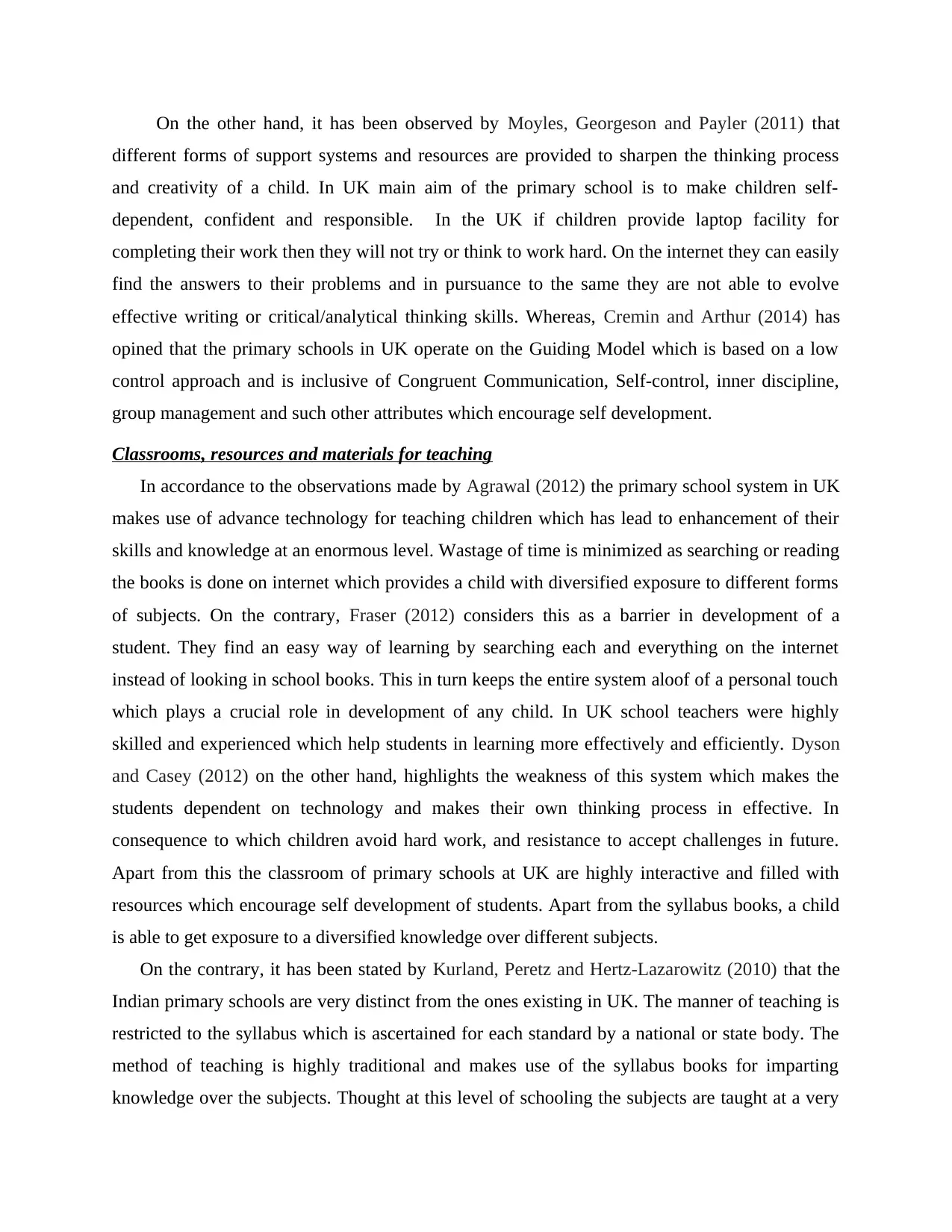
On the other hand, it has been observed by Moyles, Georgeson and Payler (2011) that
different forms of support systems and resources are provided to sharpen the thinking process
and creativity of a child. In UK main aim of the primary school is to make children self-
dependent, confident and responsible. In the UK if children provide laptop facility for
completing their work then they will not try or think to work hard. On the internet they can easily
find the answers to their problems and in pursuance to the same they are not able to evolve
effective writing or critical/analytical thinking skills. Whereas, Cremin and Arthur (2014) has
opined that the primary schools in UK operate on the Guiding Model which is based on a low
control approach and is inclusive of Congruent Communication, Self-control, inner discipline,
group management and such other attributes which encourage self development.
Classrooms, resources and materials for teaching
In accordance to the observations made by Agrawal (2012) the primary school system in UK
makes use of advance technology for teaching children which has lead to enhancement of their
skills and knowledge at an enormous level. Wastage of time is minimized as searching or reading
the books is done on internet which provides a child with diversified exposure to different forms
of subjects. On the contrary, Fraser (2012) considers this as a barrier in development of a
student. They find an easy way of learning by searching each and everything on the internet
instead of looking in school books. This in turn keeps the entire system aloof of a personal touch
which plays a crucial role in development of any child. In UK school teachers were highly
skilled and experienced which help students in learning more effectively and efficiently. Dyson
and Casey (2012) on the other hand, highlights the weakness of this system which makes the
students dependent on technology and makes their own thinking process in effective. In
consequence to which children avoid hard work, and resistance to accept challenges in future.
Apart from this the classroom of primary schools at UK are highly interactive and filled with
resources which encourage self development of students. Apart from the syllabus books, a child
is able to get exposure to a diversified knowledge over different subjects.
On the contrary, it has been stated by Kurland, Peretz and Hertz-Lazarowitz (2010) that the
Indian primary schools are very distinct from the ones existing in UK. The manner of teaching is
restricted to the syllabus which is ascertained for each standard by a national or state body. The
method of teaching is highly traditional and makes use of the syllabus books for imparting
knowledge over the subjects. Thought at this level of schooling the subjects are taught at a very
different forms of support systems and resources are provided to sharpen the thinking process
and creativity of a child. In UK main aim of the primary school is to make children self-
dependent, confident and responsible. In the UK if children provide laptop facility for
completing their work then they will not try or think to work hard. On the internet they can easily
find the answers to their problems and in pursuance to the same they are not able to evolve
effective writing or critical/analytical thinking skills. Whereas, Cremin and Arthur (2014) has
opined that the primary schools in UK operate on the Guiding Model which is based on a low
control approach and is inclusive of Congruent Communication, Self-control, inner discipline,
group management and such other attributes which encourage self development.
Classrooms, resources and materials for teaching
In accordance to the observations made by Agrawal (2012) the primary school system in UK
makes use of advance technology for teaching children which has lead to enhancement of their
skills and knowledge at an enormous level. Wastage of time is minimized as searching or reading
the books is done on internet which provides a child with diversified exposure to different forms
of subjects. On the contrary, Fraser (2012) considers this as a barrier in development of a
student. They find an easy way of learning by searching each and everything on the internet
instead of looking in school books. This in turn keeps the entire system aloof of a personal touch
which plays a crucial role in development of any child. In UK school teachers were highly
skilled and experienced which help students in learning more effectively and efficiently. Dyson
and Casey (2012) on the other hand, highlights the weakness of this system which makes the
students dependent on technology and makes their own thinking process in effective. In
consequence to which children avoid hard work, and resistance to accept challenges in future.
Apart from this the classroom of primary schools at UK are highly interactive and filled with
resources which encourage self development of students. Apart from the syllabus books, a child
is able to get exposure to a diversified knowledge over different subjects.
On the contrary, it has been stated by Kurland, Peretz and Hertz-Lazarowitz (2010) that the
Indian primary schools are very distinct from the ones existing in UK. The manner of teaching is
restricted to the syllabus which is ascertained for each standard by a national or state body. The
method of teaching is highly traditional and makes use of the syllabus books for imparting
knowledge over the subjects. Thought at this level of schooling the subjects are taught at a very
Paraphrase This Document
Need a fresh take? Get an instant paraphrase of this document with our AI Paraphraser
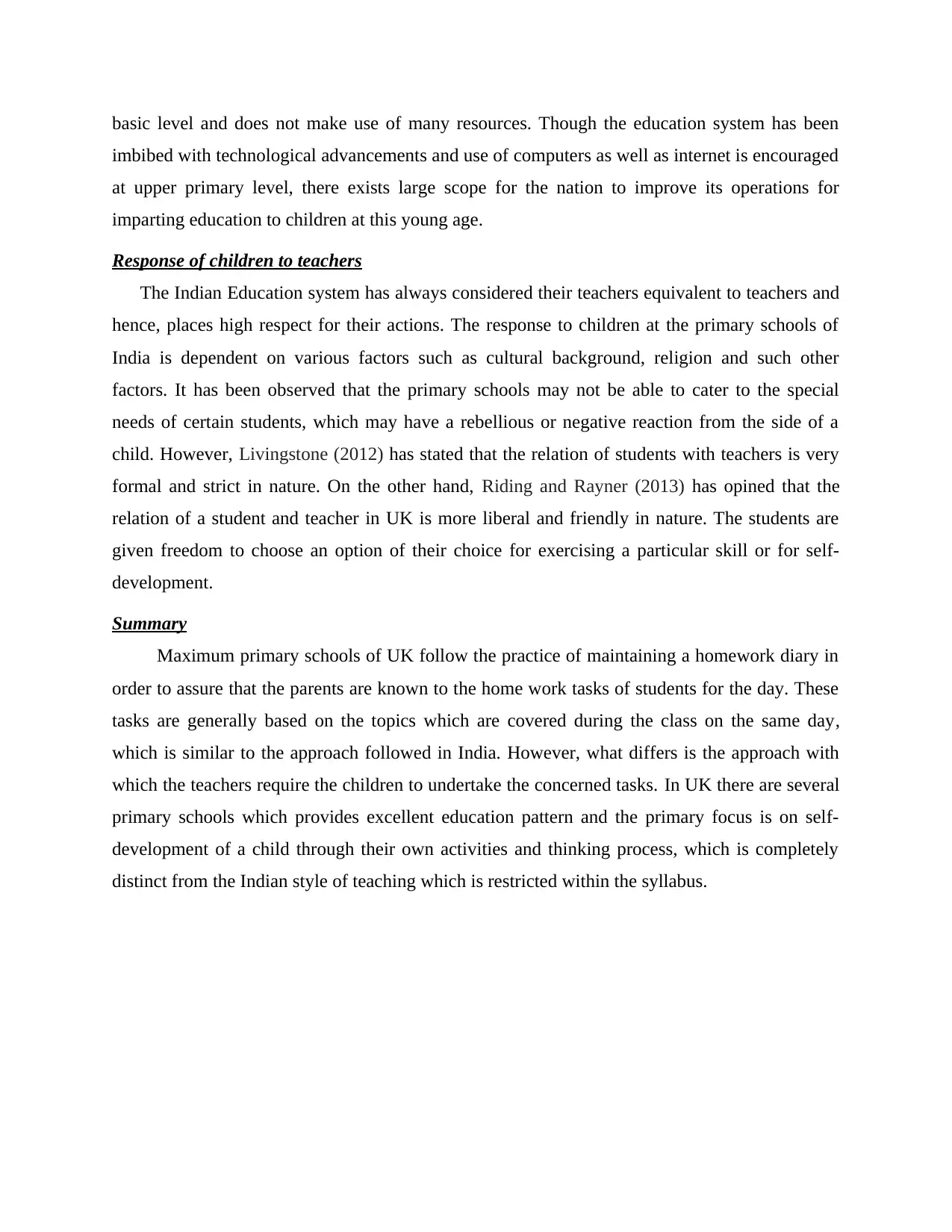
basic level and does not make use of many resources. Though the education system has been
imbibed with technological advancements and use of computers as well as internet is encouraged
at upper primary level, there exists large scope for the nation to improve its operations for
imparting education to children at this young age.
Response of children to teachers
The Indian Education system has always considered their teachers equivalent to teachers and
hence, places high respect for their actions. The response to children at the primary schools of
India is dependent on various factors such as cultural background, religion and such other
factors. It has been observed that the primary schools may not be able to cater to the special
needs of certain students, which may have a rebellious or negative reaction from the side of a
child. However, Livingstone (2012) has stated that the relation of students with teachers is very
formal and strict in nature. On the other hand, Riding and Rayner (2013) has opined that the
relation of a student and teacher in UK is more liberal and friendly in nature. The students are
given freedom to choose an option of their choice for exercising a particular skill or for self-
development.
Summary
Maximum primary schools of UK follow the practice of maintaining a homework diary in
order to assure that the parents are known to the home work tasks of students for the day. These
tasks are generally based on the topics which are covered during the class on the same day,
which is similar to the approach followed in India. However, what differs is the approach with
which the teachers require the children to undertake the concerned tasks. In UK there are several
primary schools which provides excellent education pattern and the primary focus is on self-
development of a child through their own activities and thinking process, which is completely
distinct from the Indian style of teaching which is restricted within the syllabus.
imbibed with technological advancements and use of computers as well as internet is encouraged
at upper primary level, there exists large scope for the nation to improve its operations for
imparting education to children at this young age.
Response of children to teachers
The Indian Education system has always considered their teachers equivalent to teachers and
hence, places high respect for their actions. The response to children at the primary schools of
India is dependent on various factors such as cultural background, religion and such other
factors. It has been observed that the primary schools may not be able to cater to the special
needs of certain students, which may have a rebellious or negative reaction from the side of a
child. However, Livingstone (2012) has stated that the relation of students with teachers is very
formal and strict in nature. On the other hand, Riding and Rayner (2013) has opined that the
relation of a student and teacher in UK is more liberal and friendly in nature. The students are
given freedom to choose an option of their choice for exercising a particular skill or for self-
development.
Summary
Maximum primary schools of UK follow the practice of maintaining a homework diary in
order to assure that the parents are known to the home work tasks of students for the day. These
tasks are generally based on the topics which are covered during the class on the same day,
which is similar to the approach followed in India. However, what differs is the approach with
which the teachers require the children to undertake the concerned tasks. In UK there are several
primary schools which provides excellent education pattern and the primary focus is on self-
development of a child through their own activities and thinking process, which is completely
distinct from the Indian style of teaching which is restricted within the syllabus.
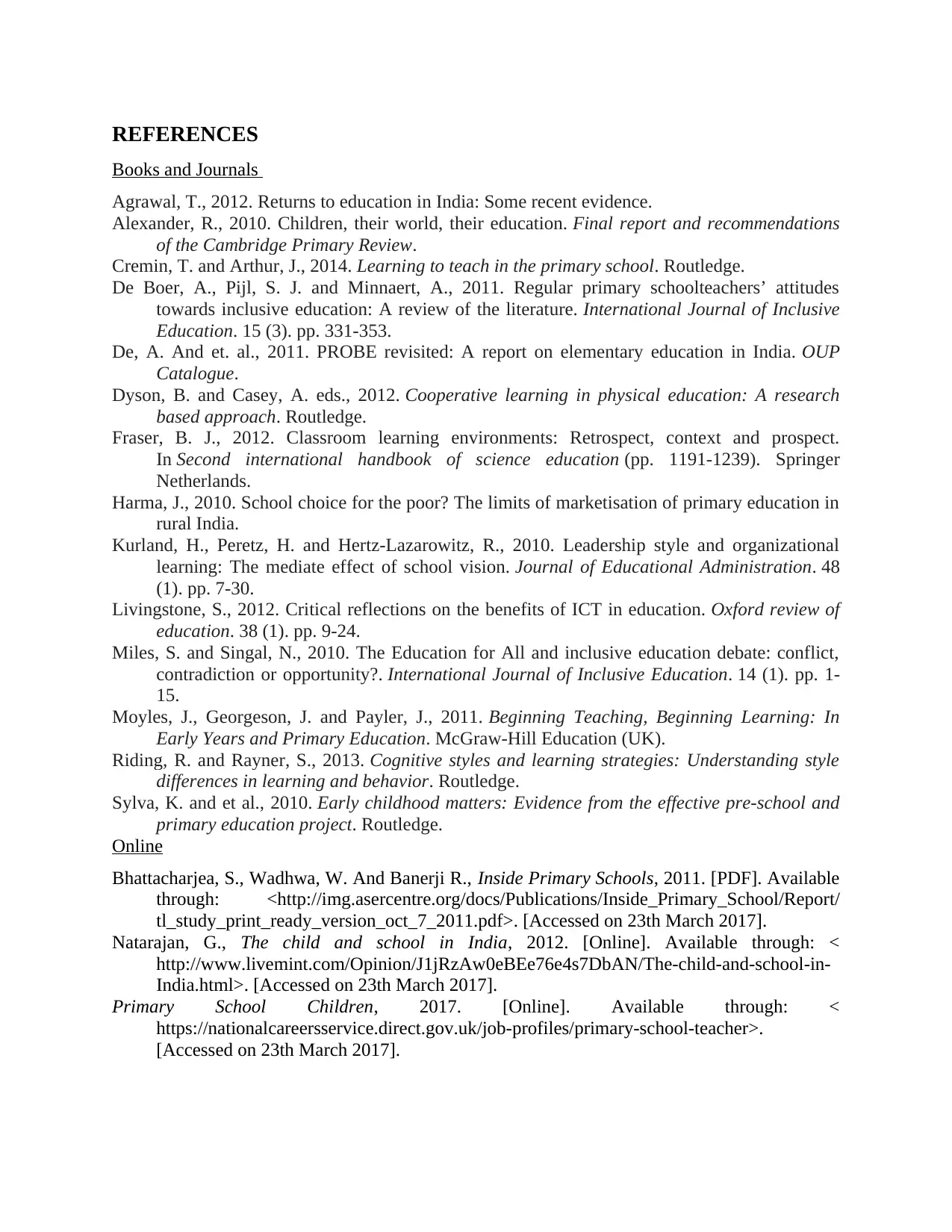
REFERENCES
Books and Journals
Agrawal, T., 2012. Returns to education in India: Some recent evidence.
Alexander, R., 2010. Children, their world, their education. Final report and recommendations
of the Cambridge Primary Review.
Cremin, T. and Arthur, J., 2014. Learning to teach in the primary school. Routledge.
De Boer, A., Pijl, S. J. and Minnaert, A., 2011. Regular primary schoolteachers’ attitudes
towards inclusive education: A review of the literature. International Journal of Inclusive
Education. 15 (3). pp. 331-353.
De, A. And et. al., 2011. PROBE revisited: A report on elementary education in India. OUP
Catalogue.
Dyson, B. and Casey, A. eds., 2012. Cooperative learning in physical education: A research
based approach. Routledge.
Fraser, B. J., 2012. Classroom learning environments: Retrospect, context and prospect.
In Second international handbook of science education (pp. 1191-1239). Springer
Netherlands.
Harma, J., 2010. School choice for the poor? The limits of marketisation of primary education in
rural India.
Kurland, H., Peretz, H. and Hertz-Lazarowitz, R., 2010. Leadership style and organizational
learning: The mediate effect of school vision. Journal of Educational Administration. 48
(1). pp. 7-30.
Livingstone, S., 2012. Critical reflections on the benefits of ICT in education. Oxford review of
education. 38 (1). pp. 9-24.
Miles, S. and Singal, N., 2010. The Education for All and inclusive education debate: conflict,
contradiction or opportunity?. International Journal of Inclusive Education. 14 (1). pp. 1-
15.
Moyles, J., Georgeson, J. and Payler, J., 2011. Beginning Teaching, Beginning Learning: In
Early Years and Primary Education. McGraw-Hill Education (UK).
Riding, R. and Rayner, S., 2013. Cognitive styles and learning strategies: Understanding style
differences in learning and behavior. Routledge.
Sylva, K. and et al., 2010. Early childhood matters: Evidence from the effective pre-school and
primary education project. Routledge.
Online
Bhattacharjea, S., Wadhwa, W. And Banerji R., Inside Primary Schools, 2011. [PDF]. Available
through: <http://img.asercentre.org/docs/Publications/Inside_Primary_School/Report/
tl_study_print_ready_version_oct_7_2011.pdf>. [Accessed on 23th March 2017].
Natarajan, G., The child and school in India, 2012. [Online]. Available through: <
http://www.livemint.com/Opinion/J1jRzAw0eBEe76e4s7DbAN/The-child-and-school-in-
India.html>. [Accessed on 23th March 2017].
Primary School Children, 2017. [Online]. Available through: <
https://nationalcareersservice.direct.gov.uk/job-profiles/primary-school-teacher>.
[Accessed on 23th March 2017].
Books and Journals
Agrawal, T., 2012. Returns to education in India: Some recent evidence.
Alexander, R., 2010. Children, their world, their education. Final report and recommendations
of the Cambridge Primary Review.
Cremin, T. and Arthur, J., 2014. Learning to teach in the primary school. Routledge.
De Boer, A., Pijl, S. J. and Minnaert, A., 2011. Regular primary schoolteachers’ attitudes
towards inclusive education: A review of the literature. International Journal of Inclusive
Education. 15 (3). pp. 331-353.
De, A. And et. al., 2011. PROBE revisited: A report on elementary education in India. OUP
Catalogue.
Dyson, B. and Casey, A. eds., 2012. Cooperative learning in physical education: A research
based approach. Routledge.
Fraser, B. J., 2012. Classroom learning environments: Retrospect, context and prospect.
In Second international handbook of science education (pp. 1191-1239). Springer
Netherlands.
Harma, J., 2010. School choice for the poor? The limits of marketisation of primary education in
rural India.
Kurland, H., Peretz, H. and Hertz-Lazarowitz, R., 2010. Leadership style and organizational
learning: The mediate effect of school vision. Journal of Educational Administration. 48
(1). pp. 7-30.
Livingstone, S., 2012. Critical reflections on the benefits of ICT in education. Oxford review of
education. 38 (1). pp. 9-24.
Miles, S. and Singal, N., 2010. The Education for All and inclusive education debate: conflict,
contradiction or opportunity?. International Journal of Inclusive Education. 14 (1). pp. 1-
15.
Moyles, J., Georgeson, J. and Payler, J., 2011. Beginning Teaching, Beginning Learning: In
Early Years and Primary Education. McGraw-Hill Education (UK).
Riding, R. and Rayner, S., 2013. Cognitive styles and learning strategies: Understanding style
differences in learning and behavior. Routledge.
Sylva, K. and et al., 2010. Early childhood matters: Evidence from the effective pre-school and
primary education project. Routledge.
Online
Bhattacharjea, S., Wadhwa, W. And Banerji R., Inside Primary Schools, 2011. [PDF]. Available
through: <http://img.asercentre.org/docs/Publications/Inside_Primary_School/Report/
tl_study_print_ready_version_oct_7_2011.pdf>. [Accessed on 23th March 2017].
Natarajan, G., The child and school in India, 2012. [Online]. Available through: <
http://www.livemint.com/Opinion/J1jRzAw0eBEe76e4s7DbAN/The-child-and-school-in-
India.html>. [Accessed on 23th March 2017].
Primary School Children, 2017. [Online]. Available through: <
https://nationalcareersservice.direct.gov.uk/job-profiles/primary-school-teacher>.
[Accessed on 23th March 2017].
⊘ This is a preview!⊘
Do you want full access?
Subscribe today to unlock all pages.

Trusted by 1+ million students worldwide
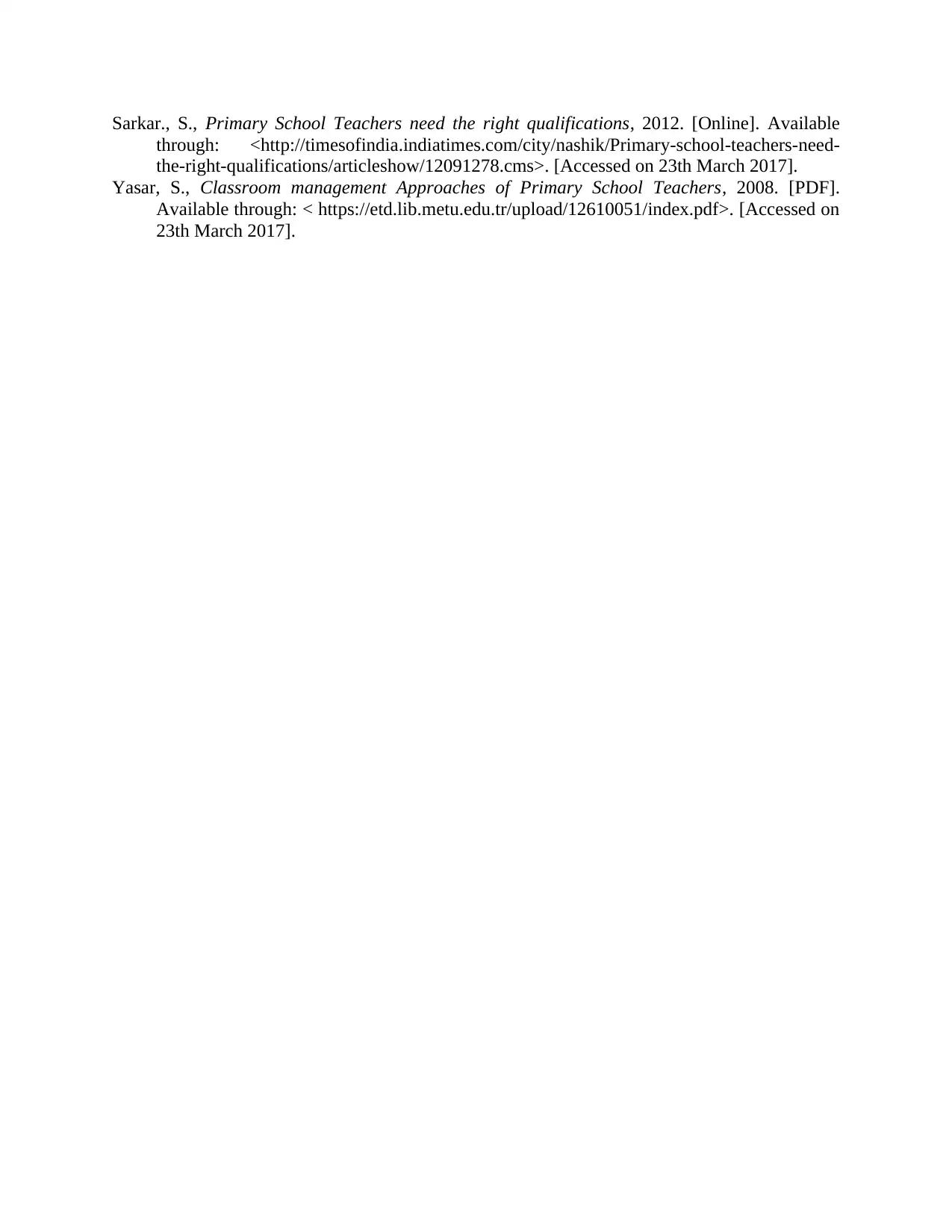
Sarkar., S., Primary School Teachers need the right qualifications, 2012. [Online]. Available
through: <http://timesofindia.indiatimes.com/city/nashik/Primary-school-teachers-need-
the-right-qualifications/articleshow/12091278.cms>. [Accessed on 23th March 2017].
Yasar, S., Classroom management Approaches of Primary School Teachers, 2008. [PDF].
Available through: < https://etd.lib.metu.edu.tr/upload/12610051/index.pdf>. [Accessed on
23th March 2017].
through: <http://timesofindia.indiatimes.com/city/nashik/Primary-school-teachers-need-
the-right-qualifications/articleshow/12091278.cms>. [Accessed on 23th March 2017].
Yasar, S., Classroom management Approaches of Primary School Teachers, 2008. [PDF].
Available through: < https://etd.lib.metu.edu.tr/upload/12610051/index.pdf>. [Accessed on
23th March 2017].
Paraphrase This Document
Need a fresh take? Get an instant paraphrase of this document with our AI Paraphraser
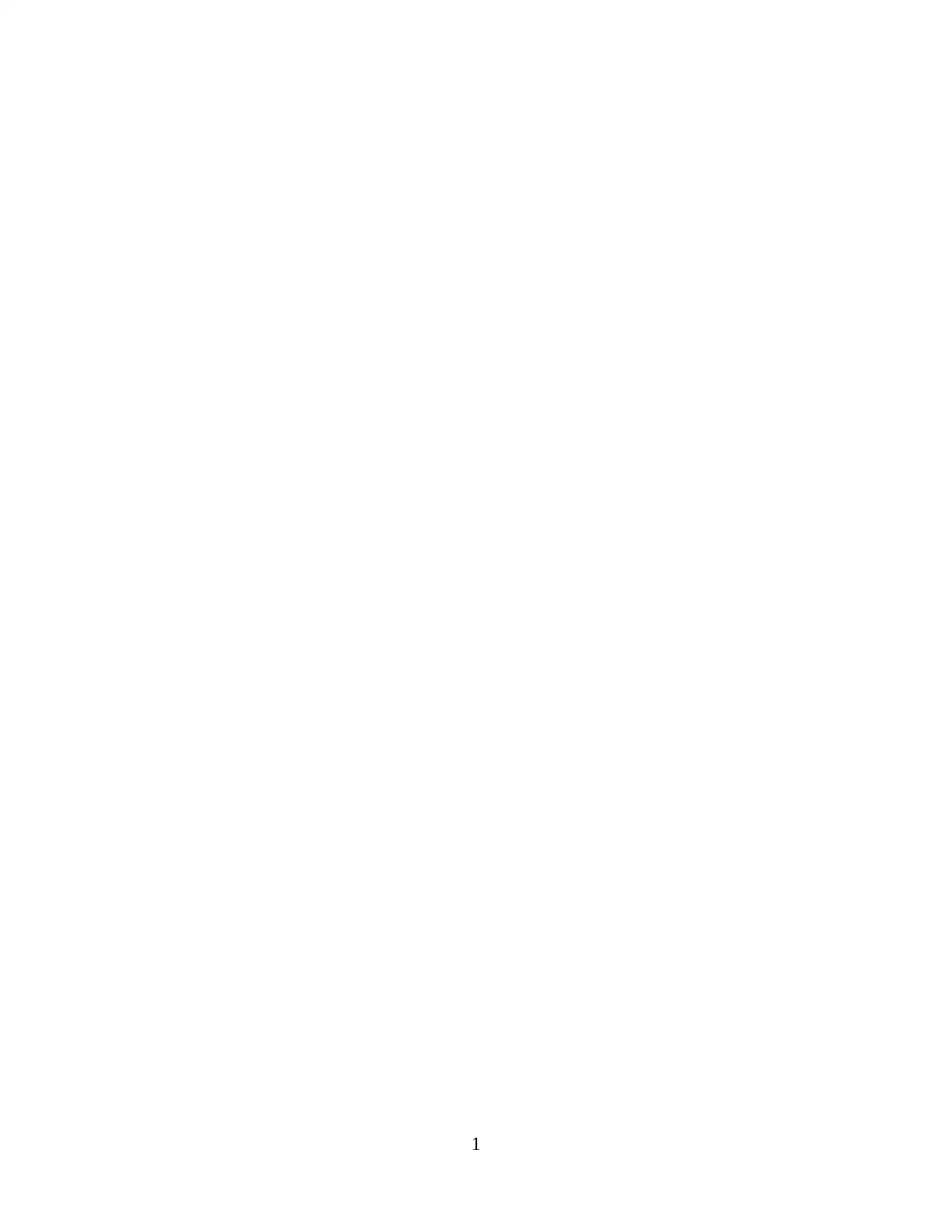
1
1 out of 11
Related Documents
Your All-in-One AI-Powered Toolkit for Academic Success.
+13062052269
info@desklib.com
Available 24*7 on WhatsApp / Email
![[object Object]](/_next/static/media/star-bottom.7253800d.svg)
Unlock your academic potential
Copyright © 2020–2025 A2Z Services. All Rights Reserved. Developed and managed by ZUCOL.





